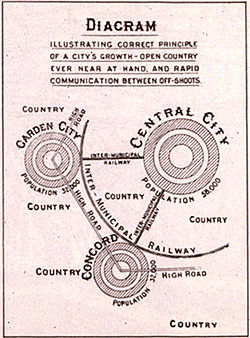
Back Tuinstad Afrikaans نظرية المدينة الحدائقية Arabic Ciutat jardí Catalan Zahradní město Czech Haveby Danish Gartenstadt German Ĝardena urbo Esperanto Ciudad jardín Spanish Aedlinn Estonian Lorategi-hiri Basque


The garden city movement was a 20th century urban planning movement promoting satellite communities surrounding the central city and separated with greenbelts. These Garden Cities would contain proportionate areas of residences, industry, and agriculture. Ebenezer Howard first posited the idea in 1898 as a way to capture the primary benefits of the countryside and the city while avoiding the disadvantages presented by both. In the early 20th century, Letchworth, Brentham Garden Suburb, and Welwyn Garden City were built in or near London according to Howard's concept and many other garden cities inspired by his model have since been built all over the world.[1]
- ^ Caves, R. W. (2004). Encyclopedia of the City. Routledge. p. 281.